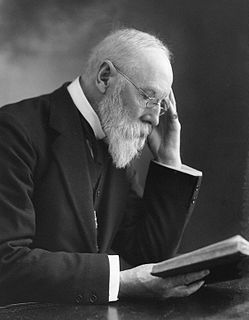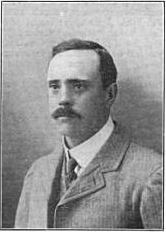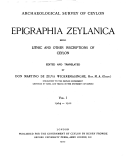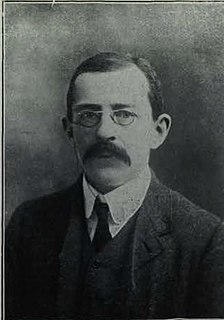
Colonel William Henry Sykes, FRS was an English naturalist who served with the British military in India and was specifically known for his work with the Indian Army as a politician, Indologist and ornithologist. One of the pioneers of the Victorian statistical movement, a founder of the Royal Statistical Society, he conducted surveys and examined the efficiency of army operation. Returning from service in India, he became a director of the East India Company and a member of parliament representing Aberdeen.
Augustus Frederic Rudolf Hoernlé CIE, also referred to as Rudolf Hoernle or A. F. Rudolf Hoernle, was an Indologist and philologist. He is famous for his studies on the Bower Manuscript (1891), Weber Manuscript (1893) and other discoveries in northwestern China and Central Asia particularly in collaboration with Aurel Stein. Born in India to a Protestant missionary family from Germany, he completed his education in Switzerland, and studied Sanskrit in the United Kingdom. He returned to India, taught at leading universities there, and in the early 1890s published a series of seminal papers on ancient manuscripts, writing scripts and cultural exchange between India, China and Central Asia. His collection after 1895 became a victim of forgery by Islam Akhun and colleagues in Central Asia, a forgery revealed to him in 1899. He retired from the Indian office in 1899 and settled in Oxford, where he continued to work through the 1910s on archaeological discoveries in Central Asia and India. This is now referred to as the "Hoernle collection" at the British Library.

The Indian Museum in Kolkata, West Bengal, India, also referred to as the Imperial Museum at Calcutta in colonial-era texts, is the ninth oldest museum in the world, the oldest museum in India, and the largest museum in India. It has rare collections of antiques, armour and ornaments, fossils, skeletons, mummies and Mughal paintings. It was founded by the Asiatic Society of Bengal in Kolkata (Calcutta), India, in 1814. The founder curator was Nathaniel Wallich, a Danish botanist.

John Clark Marshman was an English journalist and historian. He was editor and publisher of the Calcutta-based Friend of India and was involved with several other Indian publications.

Major General Sir Alexander Cunningham was a British army engineer with the Bengal Engineer Group who later took an interest in the history and archaeology of India. In 1861, he was appointed to the newly created position of archaeological surveyor to the government of India; and he founded and organised what later became the Archaeological Surveyor of India.

The Archaeological Survey of India is an Indian government agency attached to the Ministry of Culture that is responsible for archaeological research and the conservation and preservation of cultural monuments in the country. It was founded in 1861 by Alexander Cunningham who also became its first Director-General.

Ramesh Chandra Majumdar was a historian and professor of Indian history. He was a former Sheriff of Kolkata.

Piprahwa is a village near Birdpur in Siddharthnagar district of the Indian state of Uttar Pradesh. Kalanamak rice, a scented and spicy variety of rice is grown in this area. It lies in the heart of the historical Buddha's homeland and is 12 miles from the world heritage site of Lumbini that is believed to be the place of Gautama Buddha's birth.

Sir Jadunath Sarkar CIE was a prominent Indian historian especially of the Mughal dynasty.

Sir George Abraham Grierson was an Irish administrator and linguist in British India. He worked in the Indian Civil Services but an interest in philology and linguistics led him to pursue studies in the languages and folklore of India during his postings in Bengal and Bihar. He published numerous studies in the journals of learned societies and wrote several books during his administrative career but proposed a formal linguistic survey at the Oriental Congress in 1886 at Vienna. The Congress recommended the idea to the British Government and he was appointed superintendent of the newly created Linguistic Survey of India in 1898. He continued the work until 1928, surveying people across the British Indian territory, documenting spoken languages, recording voices, written forms and was responsible in documenting information on 179 languages, defined by him through a test of mutual unintelligibility, and 544 dialects which he placed in five language families. He published the findings of the Linguistic Survey in a series that consisted of 19 volumes.
Mansel Longworth Dames (1850–1922) was a scholar of oriental and Portuguese languages.
Sir William Foster was a British historiographer and civil servant who was Registrar and Superintendent of Records in the India Office. He was a member of the Hakluyt Society and was "the foremost authority on the detailed history of early British relations with India and other countries in Asia."

Edward Arthur Henry Blunt, ICS, was a British civil servant in India during the British Raj and a scholarly writer.

Epigraphia Zeylanica is an irregularly published series that deals with epigraphs and other records from ancient Ceylon. Established in 1904, the series' contents range from individual articles and notes on inscriptions to single-author monographs. Over the last century, Epigraphia Zeylanica has functioned as a key source for the history of ancient Ceylon and its early epigraphic records.

Friedrich Oscar Oertel was a German-born engineer, architect, and archaeologist. He is best known among Indian art historians and archaeologists for having excavated the archaeological site of Sarnath in the winter of 1904–1905. It was here that in March 1905 he unearthed the Lion Capital of Ashoka of an Ashokan pillar, which was to become the national emblem of India. However, probably because he was mainly involved as a civil engineer and architect in the Public Works Department, his contributions to the fields of art history and archaeology are largely overlooked in the historiography of South Asian art and archaeology.
Franklin Edgerton was an American linguistic scholar. He was Salisbury Professor of Sanskrit and Comparative Philology at Yale University (1926) and visiting professor at Benares Hindu University (1953–4). Between 1913 and 1926, he was the Professor of Sanskrit at the University of Pennsylvania. He is well known for his exceptionally literal translation of the Bhagavad Gita which was published as volume 38-39 of the Harvard Oriental Series in 1944. He also edited the parallel edition of four recensions of the Simhāsana Dvātrṃśika, and a reconstruction of the (lost) original Sanskrit text of the Panchatantra.
Rai Bahadur Daya Ram SahniCIE was an Indian archaeologist who supervised the excavation of the Indus valley site at Harappa in 1921 and 1922. A protege of John Marshall, in 1931, Sahni became the first Indian to be appointed Director-General of the Archaeological Survey of India (ASI), a position in which he served till 1935.
Leonard John Sedgwick was an Indian civil servant who worked in the Bombay Presidency and collected and described plants as an amateur botanist. His collections are held in St Xavier's College, Bombay.

William Harrison Moreland was a British civil servant who served in the Indian Civil Service and wrote several books on the economic history of India based on Mughal, Dutch, and Portuguese sources.

Charles Evelyn Arbuthnot William Oldham or C.E.A.W. Oldham was a British Indian civil servant, historian and scholar.














